B: Thank you, Mr. Sarker, for listening to our programs on both shortwave radio and Facebook livestream. We welcome your comments and questions for the hosts and guests. All livestream programs are also available for re-listening on our website: www.vovworld.vn.
A: Ratan Kumar Paul of India wants to know who were the first Vietnamese to climb Nepal’s legendary Mt. Everest. Everest, the world’s highest mountain, has inspired many people to attempt the difficult and dangerous ascent to its top. In May, 2008, a team of Vietnamese mountaineers successfully conquered the roof of the world.
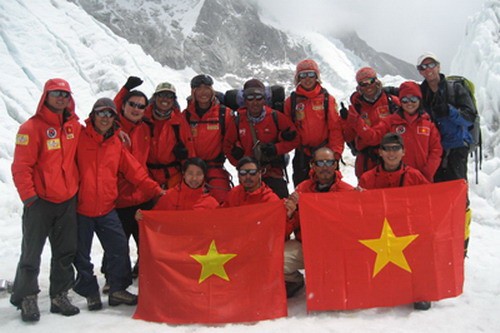 The Vietnam Everest climbing team in 2008. The Vietnam Everest climbing team in 2008.
|
B: The Vietnam national flag was held aloft at the 8,850m summit by three men, Bui Van Ngoi, Phan Thanh Nhien and Nguyen Mau Linh, who took part in a TV program called “Vietnamese people conquer Everest 2008”. Ngoi and Nhien were students at Vietnam’s Sports and Physical Training University and Linh was a boxer.
A: Many people say that reaching the summit of Everest is not as difficult as it used to be because there are now permanent base camps and hotels there. You can stay overnight there before making a push to cover the last 8 km to the top.
 Phan Thanh Nhien, one of the first Vietnamese to reach the Everest summit. Phan Thanh Nhien, one of the first Vietnamese to reach the Everest summit.
|
B: Fewer than 1,000 people attempt to climb Everest each year including professional climbers but only about half of them reach the summit. Professional mountaineers warn that there are huge risks in attempting Everest - death, permanent injury, and the risk of having paid for a story but not a summit.
A: Conquering Everest is a dream that a lot of people share, including me. But I’ll begin by conquering Vietnam’s Mt. Fansipan, the highest mountain in Indochina.
B: Good idea. I did it one time and it was the experience of a lifetime, trekking through dense tropical jungle and sleeping in a tent. Summer is the best time to climb Fansipan, when it’s not so cloudy. The route goes through natural conservation areas of sub-tropical forest and temperate forests full of bright yellow flowers.
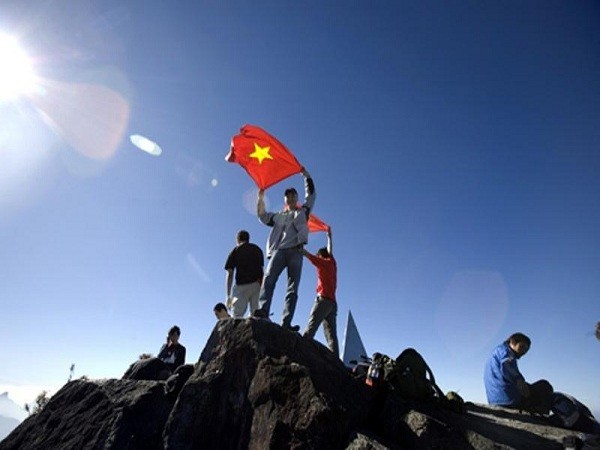 Vietnam's Fansipan, the summit of Indochina, is at 3.143m above sea level. Vietnam's Fansipan, the summit of Indochina, is at 3.143m above sea level.
|
A: The trek will take you past flowers, birds, and thousands of medicinal herbs. If you’re lucky, you’ll see partridges, bears, monkeys, and chamois. Older people, small children, and people with disabilities can take a cable car to the top. On a clear day without clouds or mist you’ll get a panoramic view of Sapa from the cable car.
B: Siddhartha Bhattacharjee of India asked this week: “How many volcanoes are there in your country?”
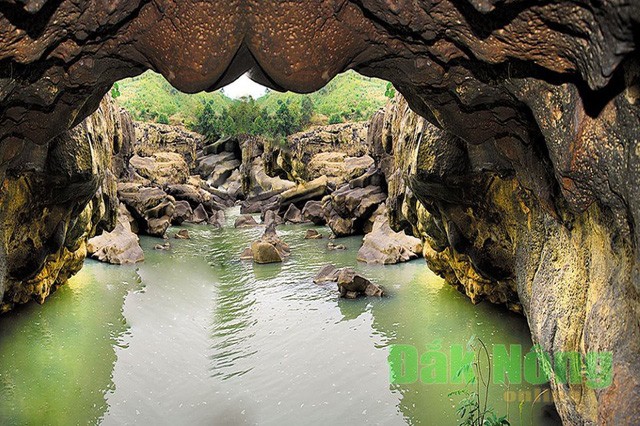 Inside one of the volcanic caves in the basalt layer of Krong No district, Vietnam's Central Highlands. Inside one of the volcanic caves in the basalt layer of Krong No district, Vietnam's Central Highlands.
|
A: Vietnam has a few volcanoes related to the subduction zone between the Eurasian and Philippine tectonic plates. But they have been inactive for millions of years. Some tourism companies now offer tours of craters and tunnels formed by the volcanoes millions of years ago.
A: Dak Nong province in the Central Highlands has the five longest lava caves in Southeast Asia. In 2007 a project was conducted to build a geological park and protect the environment of the area around Trinh Nu Waterfall in Dak Nong province in the Central Highlands of Vietnam. Scientists discovered 12 volcanic caves in the basalt layer of Krong No district.
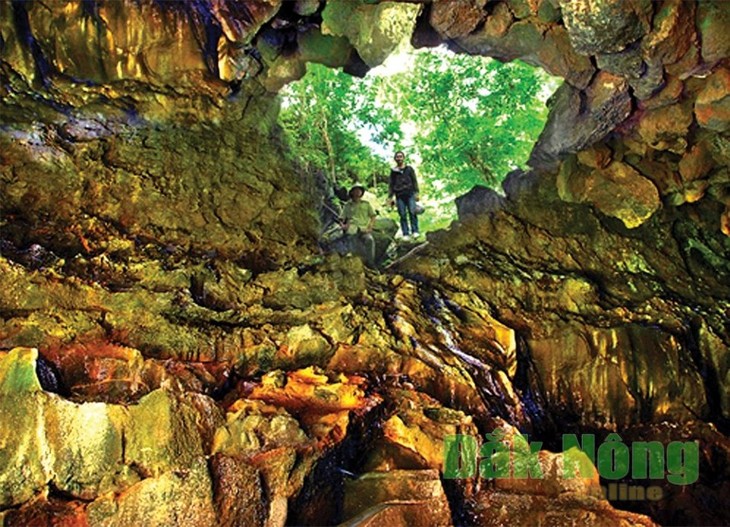 A volcanic cave in Krong No district. A volcanic cave in Krong No district. |
B: The cave system discovered in the forest had several living animal species but no traces of human habitation. Scientists have taken detailed measurements of three of the 12 caves, including a 1,000 meter cave which has been acknowledged as the longest volcanic cave in Southeast Asia. The cave contains lava banks, lava flows, sinkholes, and fossils of plants trapped in hardening basalt lava millions of years ago.
A: The Central Highlands is famous for coffee and for volcanoes like Chu Dang Ya, a popular volcano site in Gia Lai province. In the J’rai ethnic minority language, Chu Dang Ya means wild ginger. Shrouded by forests, this volcano offers enchanting mountain scenery and land made fertile for cultivation by volcanic ash.
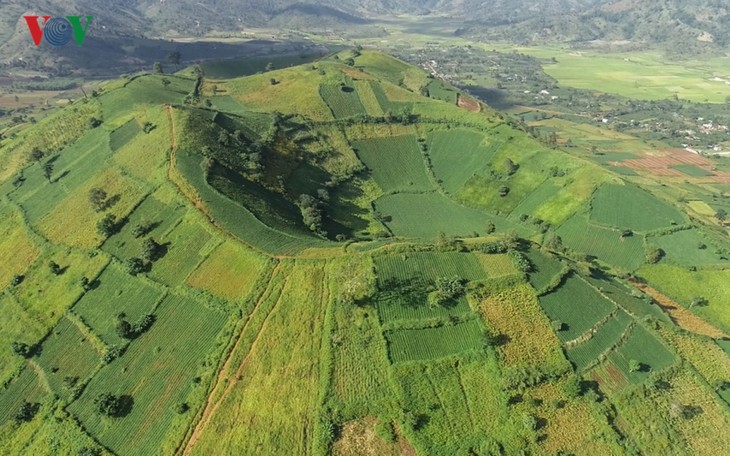 Chu Dang Ya, a popular volcano site in Gia Lai province Chu Dang Ya, a popular volcano site in Gia Lai province
|
B: During the rainy season, the steep, slippery slopes make for a treacherous trek, but the flaming red Canna lily flowers in full bloom will make you forget all the hardship and danger.
A: Richard Nowak of the US emailed us to say that our show on May 20th covered a lot of interesting events: President Ho Chi Minh’s birthday celebrations around the world, the UN Day of Vesak held in Vietnam, a Vietnamese startup company winning the Startup World Cup and a 1 million USD prize, a dance contest for students, and a choir competition with 1,000 artists from 10 countries.
B: Richard praised our Sunday Show on Vietnamese Cheo. It seems that a great many of our listeners are interested in Vietnamese folk music. Whenever we air a program on traditional Vietnamese music, we receive a lot of compliments.
A: You’re right. Our listeners worldwide are intested in exotic music from Vietnam. Our Culture segment and our Sunday Show featuring Vietnamese folk and contemporary arts are audience favorites. Richard said the traditional singing of Cheo sounded incredible. “An artist whose father taught him at age 8 to play percussion instruments has emulated his father’s singing since age 8. Cheo artists promote the conservation and appreciationof Cheo art. The interview was interesting and the Cheo singing was awesome. The village people were busy with preparations for the rice season but still found time to practice Cheo because of their love for the art. A beautiful example of Cheo singing was played. I really enjoyed this segment.”
B: If any of you missed the Sunday Show on May 20, you can listen to it on our website: www.vovworld.vn/sunday-show. Thank you, Richard, for listening to VOV and sending us your feedback. Your technical comments help our technicians monitor reception abroad.
A: We saved the best for last. We have good news from Ashik Eqbal Tokon about the VOV Spectators' Association of Bangladesh. He said the Association promotes VOV’s English broadcasts throughout the Bengali Listeners Community, which includes listeners in Bangladesh, India, and other parts of the world. They advertised the Voice of Vietnam on DX-NET, a popular DX-ing publication in the Bengali language.
B: He said that to promote VOV in 2018, the Association printed postcards and distributed them to listeners on the occasion of World Radio Day 2018. Thank you very much for your great work, Ashik. We have looked at the pdf version of the magazine that you sent us. Although we don’t understand Bengali, the layout of the magazine was really eye-catching.
A: The VOV ad was impressive. It said: “Tune in to Voice of Vietnam to discover more of this Southeast Asian country, known for its beaches, rivers, Buddhist pagodas and bustling cities. Hanoi, the capital, pays homage to the nation’s iconic leader, Ho Chi Minh, via a huge marble mausoleum. Voice of Vietnam is available on shortwave and the internet at www.vovworld.vn.”
B: Thank you so much for your dedication and help in promotingVOV to people in your community. We’ll send some VOV pennants as a thank you to your club members.
A: We hope to receive regular feedback from you and other listeners worldwide. We welcome your feedback at: English Service, VOVWORLD, the Voice of Vietnam, 45 Ba Trieu street, Hanoi, Vietnam. You can email us at: englishsection@vov.org.vn. Goodbye.